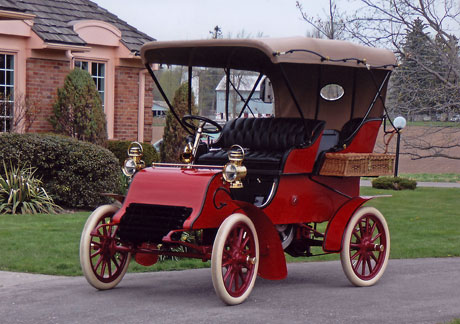Founded by Henry Leland and Robert Faulconer, the Cadillac Automobile Company of Detroit completed its first car in October 1902. The firm’s superior manufacturing technology-precise gear cutting was Leland and Faulconer’s specialty-soon established it as the foremost builder of quality cars in the United States. The company was formed using funds supplied by two of Henry Ford’s ex-backers and took its name from Le Sieur Antoine de la Mothe Cadillac, the great French 17th century explorer who founded Detroit in 1701.
The 1903 Cadillac Runabout Rear-Entrance Tonneau offered here, serial number 13, is the oldest known surviving Cadillac. It was one of three displayed at the New York Automobile Show in January 1903, the others being numbers 10 and 11.
An excellent performer by the standards of the day, the Cadillac’s 98-ci, single-cylinder engine (“Little Hercules”) was mounted on the left beneath the front seat and drove through a two-speed-plus-reverse planetary transmission by chain drive to the rear axle.
This Cadillac Runabout was bought by the owner of the Thomas Winery in Cucamonga, CA, where it was displayed until February 1973. At that point it was sold and in 1985 was restored by Herman Stoebel, now deceased. A complete photographic record was made of the restoration, illustrating the various differences-some obvious, some less so-that distinguish the earliest examples from the later production models of 1903. The most obvious differences are the protruding radiator on the earliest cars and the completely different body panel below the first entrance. It is believed that the early radiators were changed after about 25 cars had been made.
The three cars displayed at the 1903 New York Auto Show were the first Cadillacs shown to the public and the first ever sold. As the sole survivor of these pioneers, 13 is a vehicle of exceptional importance in the history of the American automobile industry. Quite simply, the Cadillac story started here.
SCM Analysis
Detailing
| Vehicle: | 1903 Cadillac Runabout Rear-Entrance |
| Years Produced: | 1903 |
| Number Produced: | 1,800 approx (in 1903) |
| Original List Price: | $850 |
| Tune Up Cost: | $25, spark plug and spring |
| Distributor Caps: | $150 (called timers on single cylinder cars) |
| Chassis Number Location: | None used; engine # is reference |
| Engine Number Location: | Top right of cylinder flange & right front face |
| Club Info: | HCCA, PO Box 62, Bakersfield, CA 93301 |
| Website: | http://www.hcca.org |
| Alternatives: | 1901 Panhard Levassor, 1903 Renault, 1903 Peugeot |
| Investment Grade: | A |
This 1903 Cadillac Runabout Rear-Entrance Tonneau sold for $330,000, including buyer’s premium, at the Bonhams & Butterfields auction at The Quail Lodge in Carmel Valley on August 17, 2007.
William Metzger was the driving force behind the first auto show in Detroit in 1899, and he was a convincing promoter. He was provided with two or possibly three Cadillacs, which had been produced at the Leland & Faulconer factory, for display at the 1903 New York Auto Show. He declared the Cadillac “sold out” after accepting as many as 2,286 orders (accounts of the total vary)-each with a $10 deposit. Backing up Metzger’s promotional abilities was a Cadillac that offered refinement in an era when many cars looked like a machine shop experiment. The four-passenger model sold for $850, while the single-seater cost $750, a very competitive price in the era.
Pat Herman recalls seeing the 1903 Cadillac at the Thomas Winery in the early 1960s, and was able to purchase the car ten years later. By then the winery had been sold, and the Cadillac was stored in a garage full of old refrigerators and washing machines. The 1903 Cadillac Runabout was missing numerous parts and showed the ravages of time, so the restoration, which was completed in 1989, was not a simple process. Several sources state that there were 2,497 Cadillacs produced in 1903. However, more recent research suggests the number is closer to 1,800, with the others actually being produced the following year.
Brass cars attracting more interest
Early brass cars-those built before 1915-have attracted increasing interest of late. Once thought to be relics from our fathers, or in some cases our grandfathers, they are appealing to a new generation of hobbyists who find them mechanically interesting and intriguing to drive. The Horseless Carriage Club of America has regional groups in 30 states and sponsors tours and other activities. Their national tour, “California Dreamin’,” is scheduled for June 2008. The 111th London to Brighton Veteran Car Run, which this year features American automobiles built prior to 1905, attracts hundreds of entrants and thousands of spectators. In addition, John Mozart, a California collector and SCMer, sponsors a well-attended annual Brass Era Tour in the Paso Robles area, so there is no end to the activities available.
The value of Brass Era cars has been steadily increasing. A couple of years ago, 1903 Cadillac Model As were selling for $60,000-$70,000. Now they are bringing twice that much at auction. About a year ago, a friend sold a 1903 Cadillac similar to number 13 (but with an engine number that would indicate it was manufactured in 1904) for less than $100,000 and was pleased with the transaction.
This 1903 Cadillac Runabout Rear-Entrance Tonneau is significant for a number of reasons. It had one owner for over 75 years, it’s the first Cadillac shipped to a customer, the first car shipped west of the Mississippi, and the oldest documented surviving Cadillac. Does that increase the value of this car by $150,000 and justify this sales price? I think it does.
